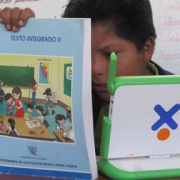Open Educational Resource for Developing Countries
By now you’ve probably heard of Sal Khan, or at least his Khan Academy. The former hedge fund manager turned education guru has been featured on PBS News Hour, CNN, NPR, NBC News, and most recently, was invited by Bill Gates to speak at TED.
There is no question that the Khan Academy’s approach is innovative. And it certainly has the potential to change the way people think about education. Sal Khan mentions in his TED Talk his desire to “flip” the classroom – where students learn the materials at home, then come to school to get extra help with the problems and mastery.
But many of the news reports on the Khan Academy stress the usage of these videos around the world – so what kind of impact could it have in developing countries?
The Khan Academy is an example of an Open Education Resource (OER), free to use teaching and learning content. Like all OER the Khan Academy has incredible potential in the developing world, while facing extreme challenges.
Benefits of OER
- Reduced costs – online, digital resources can be significantly less expensive than text books, and they can be changed edited easily to accommodate changes in the curriculum. Examples include CK12 FlexBooks and Lulu.com .
- Continuous improvements- the usage patterns of many digital products can be monitored and used as feedback. The Khan Academy is a perfect example of this- Khan found that students stopped watching some videos at certain points, so he went back and changed the content in those spots, resulting in decreased drop offs, and increased course (video) completion.
- Learning Efficiency- students can learn at their own pace by stopping and starting the videos, going back to cover ground they may have missed, or skipping material they already know
- Accessibility- videos can be captioned as well as translated into other languages. Youtube now provides captioning, and dotSUB can translate captioned material into multiple languages.
- Localization/Personalization- in many cases digital material can be created or customized to fit local culture and context. Teacher Education in SubSaharan Africa (TESSA) is one example.
But while these benefits are amazing and transforming, getting this content to students in the developing world is tough.
Challenges:
- Infrastructure – it goes without saying that students must have access to the equipment and connectivity to access materials.
- Discoverability – finding out about various materials online can be difficult.
- Quality – not all OER are created equal!
- Accessibility – although the very nature of many digital product makes it possible to be fully accessible (closed captioning for videos, screen readers for text, multiple language support, etc), not all producers think of these things, nor do all end users have the right equipment
- Interoperability – being able to use materials on any operating system, platform or device is vitally important in the developing world
- Sustainability – not only for the producers of the content (how will they stay in business) but for the end users (What kind of personnel are needed to implement a program? What happens if the resources they are counting on stop being available?)
We are just beginning to see how OER can impact students and teachers around the world. Some traditional systems and institutions may be slow to adopt, while others may see these resources as innovative solutions to long standing problems.






































